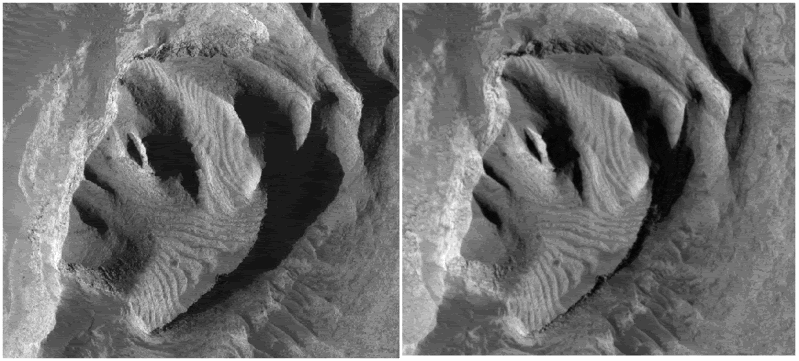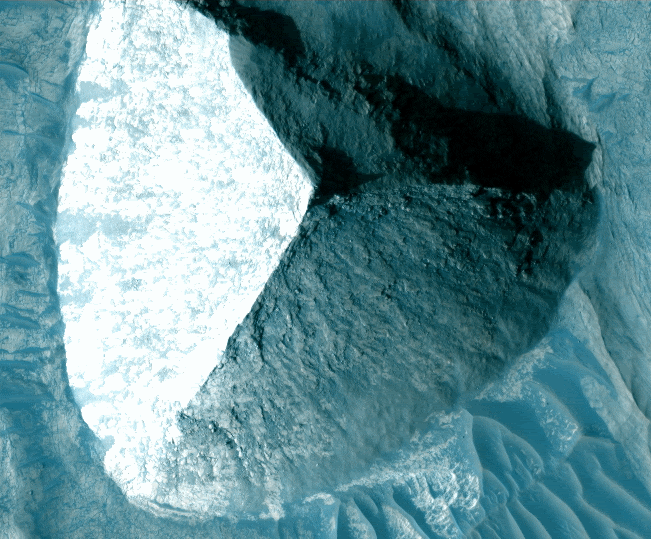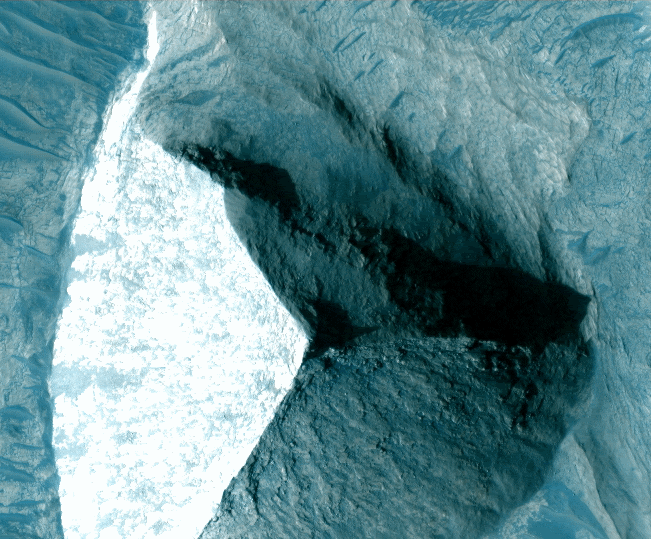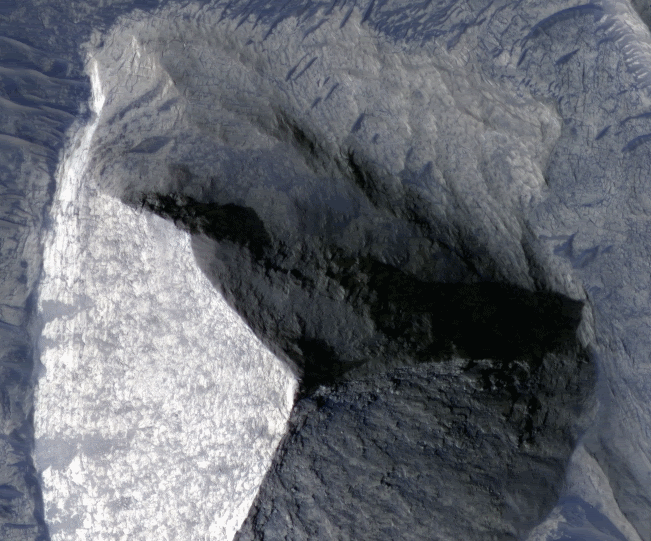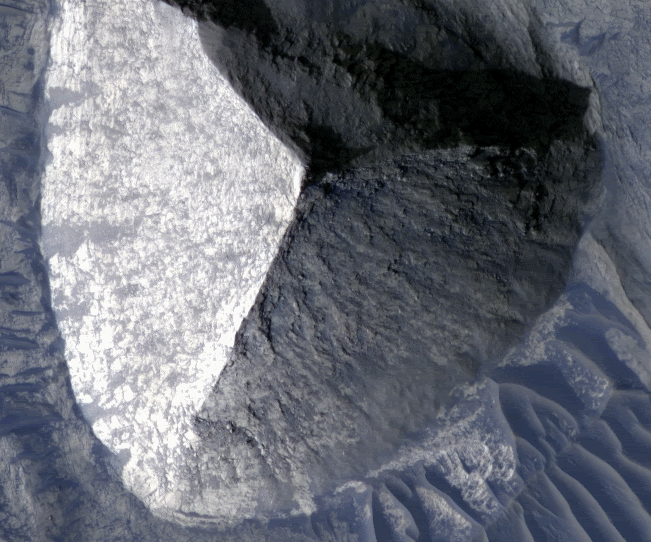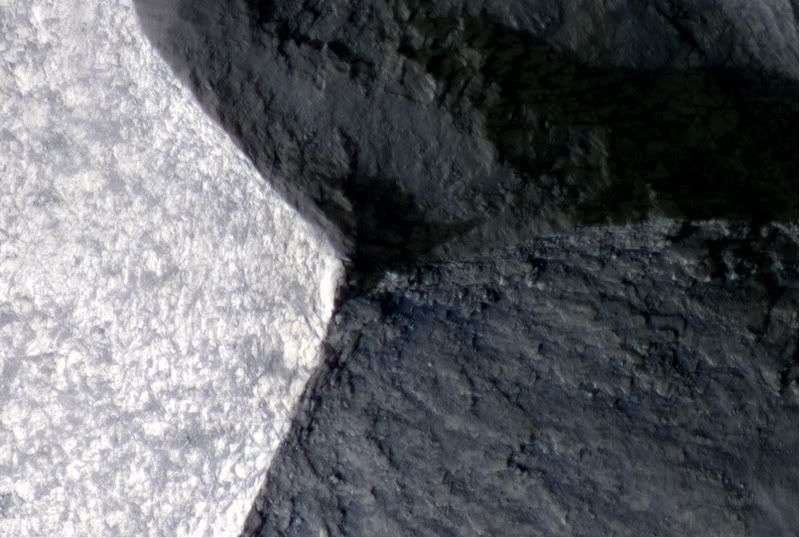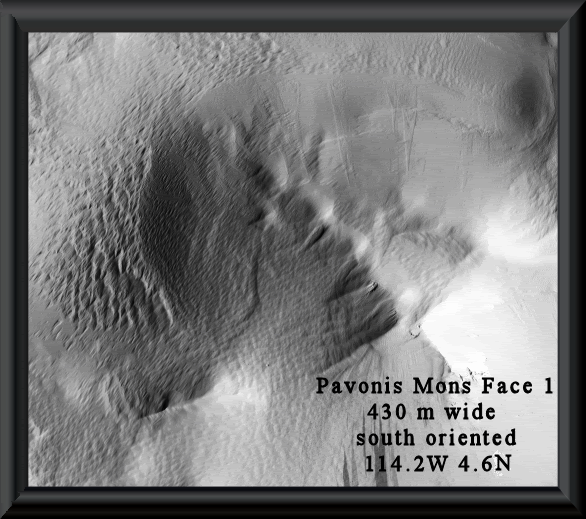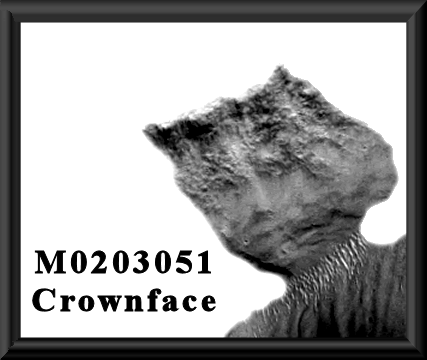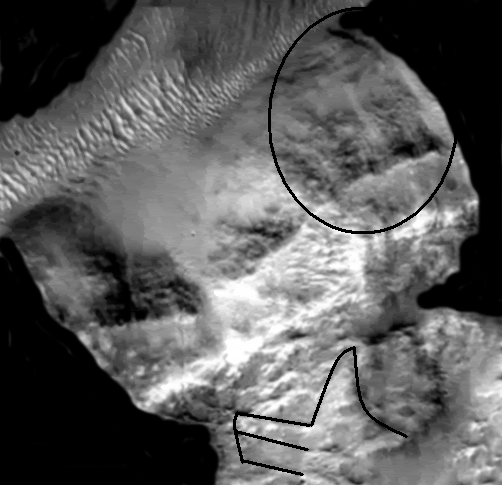- Thank you received: 0
Faces from the Chasmas
- neilderosa
-
- Offline
- Platinum Member
-

Less
More
17 years 6 months ago #18216
by neilderosa
Replied by neilderosa on topic Reply from Neil DeRosa
The last face posted, (Wil), was also re-imaged in 3896 1740. Again here are the three known images containing this face:
EO600269
PSP 002841 1740 & 3896 1740 composite; the face on the right (3896) was taken a little earlier in the day, and from more directly overhead, hence the different shadow lengths and face proportions. This is verified by the emission angle angle of 3896 (.9 deg.), and of the MOC comparison in E06, which is 0.16 degrees or almost directly overhead.
hirise.lpl.arizona.edu/PSP_003896_1740
www.msss.com/moc_gallery/e01_e06/explain.html#col13
The cutout under the “chin” of the face on the left (1740) is foreshortened somewhat compared to the same feature on face on the right. This is an indication that the MRO camera was further north when imaging 1740. It also indicates some depth of this cutout section further indicating that like Cydonia, this is a sculpture. Again this is verified by the emission angle of 1740, which is 27.7 degrees.
hirise.lpl.arizona.edu/PSP_002841_1740
EO600269
PSP 002841 1740 & 3896 1740 composite; the face on the right (3896) was taken a little earlier in the day, and from more directly overhead, hence the different shadow lengths and face proportions. This is verified by the emission angle angle of 3896 (.9 deg.), and of the MOC comparison in E06, which is 0.16 degrees or almost directly overhead.
hirise.lpl.arizona.edu/PSP_003896_1740
www.msss.com/moc_gallery/e01_e06/explain.html#col13
The cutout under the “chin” of the face on the left (1740) is foreshortened somewhat compared to the same feature on face on the right. This is an indication that the MRO camera was further north when imaging 1740. It also indicates some depth of this cutout section further indicating that like Cydonia, this is a sculpture. Again this is verified by the emission angle of 1740, which is 27.7 degrees.
hirise.lpl.arizona.edu/PSP_002841_1740
Please Log in or Create an account to join the conversation.
17 years 6 months ago #18155
by rderosa
Replied by rderosa on topic Reply from Richard DeRosa
<blockquote id="quote"><font size="2" face="Verdana, Arial, Helvetica" id="quote">quote:<hr height="1" noshade id="quote"><i>Originally posted by neilderosa</i>More important, we now see different shadows. In 3800 3899, the “chevron” I mentioned in an earlier post (but we could not see clearly even under high resolution) is back, but it now looks like a SPIRE. How do I know that? Look at the shadows in the images below; (the sun is coming from the lower left in the map-projected image.)............ But there it is. Shadows don’t lie. [Neil DeRosa]<hr height="1" noshade id="quote"></blockquote id="quote"></font id="quote">Errr......OK......so there are shadows.......hmmmm.....and?!
I'm reminded of the Woody Allen movie where some young hippie girl says to Woody, like she was telling the secret of the ancients, "Did you know that God spelled backwards is D.O.G.?" Woody looks at her kind of quizzicly, smacks his lips a couple of times and says, "Yeah.....and?!"
rd
I'm reminded of the Woody Allen movie where some young hippie girl says to Woody, like she was telling the secret of the ancients, "Did you know that God spelled backwards is D.O.G.?" Woody looks at her kind of quizzicly, smacks his lips a couple of times and says, "Yeah.....and?!"
rd
Please Log in or Create an account to join the conversation.
- neilderosa
-
- Offline
- Platinum Member
-

Less
More
- Thank you received: 0
17 years 6 months ago #18159
by neilderosa
Replied by neilderosa on topic Reply from Neil DeRosa
Since the HiRISE project is taking a closer look at Wil’s Mound (having imaged it twice when there’s still so much of Mars left unimaged in hi-res), maybe we should. I found the new image again, edited the two above posts, and here’s the link.
hirise.lpl.arizona.edu/PSP_003896_1740
Here are two versions of the mound in high resolution color, courtesy of the U of Arizona team and NASA. I cropped them large so you could see more detail, so each is in two parts. Notice; the very straight edges near the peak, the spire shadow, the very flat east and west faces, (sides), the relatively rough northern face, debris field below the northern face. [Neil DeRosa]
RGB color
IRB color
hirise.lpl.arizona.edu/PSP_003896_1740
Here are two versions of the mound in high resolution color, courtesy of the U of Arizona team and NASA. I cropped them large so you could see more detail, so each is in two parts. Notice; the very straight edges near the peak, the spire shadow, the very flat east and west faces, (sides), the relatively rough northern face, debris field below the northern face. [Neil DeRosa]
RGB color
IRB color
Please Log in or Create an account to join the conversation.
- neilderosa
-
- Offline
- Platinum Member
-

Less
More
- Thank you received: 0
17 years 5 months ago #18184
by neilderosa
Replied by neilderosa on topic Reply from Neil DeRosa
[Edited 10/27/07] I just realized that the post below lacked some context so I copied my post on this face in Trinket's thread.
<blockquote id="quote"><font size="2" face="Verdana, Arial, Helvetica" id="quote">quote:<hr height="1" noshade id="quote">Trinket,
I reviewed your flurry of postings from the last few weeks and have a few comments. First, thanks for your good faith effort to find artificial structures on Mars in the form of art works left by intelligent beings. I know you favor impressionistic art and much of your latest effort is very impressive from that standpoint. But at the risk of stirring my brother’s pot, I’ll say that some are probably pareidolic by the applied standards that have become generally accepted in the field of psychology.
However, a few may be artificial by the standards of detail, proportion and orientation, (and verified provenance), which I’ve tried to explain over the past year, and one in particular—congratulations! If you don’t mind, can you please give the link where the below image can be found. I’d like to do some further research on it and include it in my catalog of faces, giving you due credit of course as its discoverer. Thanks in advance.
Neil DeRosa
<hr height="1" noshade id="quote"></blockquote id="quote"></font id="quote">
As promised, here’s Trinket’s Pavonis Face. It is a south oriented face, located just north of Pavonis Mons at 114.2°W, 4.6°N. Its size of ~400 meters wide fits well into the range of size of most faces. Once again, the location prediction that most faces and artifacts are found on the dichotomy border is fulfilled, though not the prediction that the face would have been located at the pre-pole shift equator as calculated by Schultz and verified by Dr. Van Flandern. Also re: the location prediction, almost all faces have been at low altitudes even when found in the southern dichotomy hemisphere such as the Parrot and the Easter Island Man. The exception is the faces found in the Tharsis region such as the Profile Image (Nefertiti) and Family, and now the Pavonis face, which are at relatively high altitudes.
Also again, this face is a profile, by far the most common form of face, and most likely formed by modifying the natural terrain which may have suggested the face to the artist in the first place. The proportions, observed qualitatively, are similar to human-like proportion as are the orientation of the secondary features. There is good natural shading around the nose, forehead, and chin, which suggest that this face is a bas-relief sculpture. The mouth (likely) and the eye (possibly) are carved out, and the hairline may represent a construction mark; the hair texture is possibly added by the artist as it is markedly different from the adjacent terrain.
hirise.lpl.arizona.edu/PSP_002104_1845
<blockquote id="quote"><font size="2" face="Verdana, Arial, Helvetica" id="quote">quote:<hr height="1" noshade id="quote">Trinket,
I reviewed your flurry of postings from the last few weeks and have a few comments. First, thanks for your good faith effort to find artificial structures on Mars in the form of art works left by intelligent beings. I know you favor impressionistic art and much of your latest effort is very impressive from that standpoint. But at the risk of stirring my brother’s pot, I’ll say that some are probably pareidolic by the applied standards that have become generally accepted in the field of psychology.
However, a few may be artificial by the standards of detail, proportion and orientation, (and verified provenance), which I’ve tried to explain over the past year, and one in particular—congratulations! If you don’t mind, can you please give the link where the below image can be found. I’d like to do some further research on it and include it in my catalog of faces, giving you due credit of course as its discoverer. Thanks in advance.
Neil DeRosa
<hr height="1" noshade id="quote"></blockquote id="quote"></font id="quote">
As promised, here’s Trinket’s Pavonis Face. It is a south oriented face, located just north of Pavonis Mons at 114.2°W, 4.6°N. Its size of ~400 meters wide fits well into the range of size of most faces. Once again, the location prediction that most faces and artifacts are found on the dichotomy border is fulfilled, though not the prediction that the face would have been located at the pre-pole shift equator as calculated by Schultz and verified by Dr. Van Flandern. Also re: the location prediction, almost all faces have been at low altitudes even when found in the southern dichotomy hemisphere such as the Parrot and the Easter Island Man. The exception is the faces found in the Tharsis region such as the Profile Image (Nefertiti) and Family, and now the Pavonis face, which are at relatively high altitudes.
Also again, this face is a profile, by far the most common form of face, and most likely formed by modifying the natural terrain which may have suggested the face to the artist in the first place. The proportions, observed qualitatively, are similar to human-like proportion as are the orientation of the secondary features. There is good natural shading around the nose, forehead, and chin, which suggest that this face is a bas-relief sculpture. The mouth (likely) and the eye (possibly) are carved out, and the hairline may represent a construction mark; the hair texture is possibly added by the artist as it is markedly different from the adjacent terrain.
hirise.lpl.arizona.edu/PSP_002104_1845
Please Log in or Create an account to join the conversation.
- neilderosa
-
- Offline
- Platinum Member
-

Less
More
- Thank you received: 0
17 years 5 months ago #18236
by neilderosa
Replied by neilderosa on topic Reply from Neil DeRosa
I prefer replying to Greg Orme's post here where perhaps it is more appropriate, (partially quoted below).
<blockquote id="quote"><font size="2" face="Verdana, Arial, Helvetica" id="quote">quote:<hr height="1" noshade id="quote">3. Don't forget to accumulate information against your own theory. George Haas is becoming very good at fair scientific analysis of formations, particularly Parrotopia. Ultimately there is not much to be gained by asserting something is artificial when it is not. You get lampooned by the skeptics/cynics which makes it harder to admit you were wrong later. Better to take some shots at your own work and take the wind out of their sails, it also stops you from becoming too attached to your own impressions. I must have removed over 90% of the images from my site over the years, and it is better for removing mistakes. I happen to think the case for artifacts is stronger than ever, and if there are artifacts on Mars it is highly likely there are some still in images no one has noticed yet. Until it is proven though, no one really knows.
4. Try to look for common patterns and themes. If there was a civilisation or visitation that produced artifacts then it is likely there will be some common theme, way of building, etc. the 3 Crowned Faces, the Cydonia Face and the KK Face are highly similar to each other in overlays:
www.ultor.org/3overlays.htm
www.ultor.org/kkface.htm
www.ultor.org/faces_files/
www.ultor.org/king/King.htm
The implication here is that the faces are either all of the same alien or of aliens that look similar to each other. This is stronger evidence than faces that are very different from each other, because this is like the different faces people see in clouds. It's better to try and find an anomaly that looks like one previously found, and if geological process can be ruled out then you have either coincidence or artificiality. Like seeing 2 people who look like each other but are not related, random faces are unlikely to be very similar. It literally took more 8 years or more before I started to see any common themes.
Other studies by myself and Horace Crater show some angles between mounds near candidate artifacts are more common than others and have some mathematical significance. So finding more mounds elsewhere with the same angles is highly unlikely, and the odds against chance can be measured as hard evidence.
5. Don't be afraid of criticism and don't be afraid to criticise. Most artists have difficulty in assessing their own work without a muse or unbiased audience. If you think you see a pattern which is hard to assess scientifically, ask other people and pay attention if they think it is not as good as you think. On the other hand look for evidence that is less a matter of opinion and more scientifically justifiable. A lot of people over the years have posted nonsense on artifacts and some still do. It is hard to criticise because there is a feeling of circling the wagons against the cynics. However if you cannot say things openly try to be skeptical in private, to them if you can. In the long run it only avoids them embaressment. If they respond by criticising your work welcome it as a fresh viewpoint. I used to put up with rapid skeptics for years simply because I had no interest in defending artifacts that were natural formations. Ultimately they only do you a favor by making you look at the stronger evidence.
6. Don't feel obligated to join the fringe. Just because you think there might be artifacts on Mars doesn't obligate you to believe in UFOs, conspiracy theories and the occult. The question of Martian artifacts is a purely scientific one, and should be decided on its own merits. In my opinion if there are any artifacts on Mars at all, they are likely to be at least hundreds of millions of years old from the erosion. So they would in that theory not be connected to anything we see today, even historically.
<hr height="1" noshade id="quote"></blockquote id="quote"></font id="quote">
I agree with most of this, but also with Tom's contention that the Artificial Structures on Mars issue is an evolving paradigm, which includes the Cydonia face and perhaps one or two dozen others that we can have high confidence in for similar reasons. These are the faces that can be considered in the "mainstream of the artificiality hypothesis." Mr. Orme and others, notably Richard Hoagland, seem to be fixated on out-dated imagery, however scientific their analysis may have been at the time these images were first taken. This is certainly true of Mr. Orme's highly competent analyses. But new evidence is accumulating and must be considered.
I definitely consider the Crownface as figuring prominently in the pantheon and history of artificial structures discovered on Mars. But as yet, we have only one image, that taken by the MGS MOC (M0203051). There have been no confirmations as of yet. Although certainly the surrounding terrain has been confirmed, and other faces in the "Crownface mosaic" have been discovered both by Greg and yours truly. We also know that the Crownface and other faces of its size and south orientation are overlaid by a large 2 kilometer wide face I have called Barbara (for its resemblance to the young Streisand). Greg seems to have shied away from this face since he surely noticed it before I did, but perhaps feared its being considered "sensational" like a UFO sighting. I on the other hand take the logic and evidence wherever it leads and do not worry about the critics, with the confidence that time will vindicate us. [Neil DeRosa] [edited 10/28/07]
Crownface
Barbara with Crownface inverted in oval
<blockquote id="quote"><font size="2" face="Verdana, Arial, Helvetica" id="quote">quote:<hr height="1" noshade id="quote">3. Don't forget to accumulate information against your own theory. George Haas is becoming very good at fair scientific analysis of formations, particularly Parrotopia. Ultimately there is not much to be gained by asserting something is artificial when it is not. You get lampooned by the skeptics/cynics which makes it harder to admit you were wrong later. Better to take some shots at your own work and take the wind out of their sails, it also stops you from becoming too attached to your own impressions. I must have removed over 90% of the images from my site over the years, and it is better for removing mistakes. I happen to think the case for artifacts is stronger than ever, and if there are artifacts on Mars it is highly likely there are some still in images no one has noticed yet. Until it is proven though, no one really knows.
4. Try to look for common patterns and themes. If there was a civilisation or visitation that produced artifacts then it is likely there will be some common theme, way of building, etc. the 3 Crowned Faces, the Cydonia Face and the KK Face are highly similar to each other in overlays:
www.ultor.org/3overlays.htm
www.ultor.org/kkface.htm
www.ultor.org/faces_files/
www.ultor.org/king/King.htm
The implication here is that the faces are either all of the same alien or of aliens that look similar to each other. This is stronger evidence than faces that are very different from each other, because this is like the different faces people see in clouds. It's better to try and find an anomaly that looks like one previously found, and if geological process can be ruled out then you have either coincidence or artificiality. Like seeing 2 people who look like each other but are not related, random faces are unlikely to be very similar. It literally took more 8 years or more before I started to see any common themes.
Other studies by myself and Horace Crater show some angles between mounds near candidate artifacts are more common than others and have some mathematical significance. So finding more mounds elsewhere with the same angles is highly unlikely, and the odds against chance can be measured as hard evidence.
5. Don't be afraid of criticism and don't be afraid to criticise. Most artists have difficulty in assessing their own work without a muse or unbiased audience. If you think you see a pattern which is hard to assess scientifically, ask other people and pay attention if they think it is not as good as you think. On the other hand look for evidence that is less a matter of opinion and more scientifically justifiable. A lot of people over the years have posted nonsense on artifacts and some still do. It is hard to criticise because there is a feeling of circling the wagons against the cynics. However if you cannot say things openly try to be skeptical in private, to them if you can. In the long run it only avoids them embaressment. If they respond by criticising your work welcome it as a fresh viewpoint. I used to put up with rapid skeptics for years simply because I had no interest in defending artifacts that were natural formations. Ultimately they only do you a favor by making you look at the stronger evidence.
6. Don't feel obligated to join the fringe. Just because you think there might be artifacts on Mars doesn't obligate you to believe in UFOs, conspiracy theories and the occult. The question of Martian artifacts is a purely scientific one, and should be decided on its own merits. In my opinion if there are any artifacts on Mars at all, they are likely to be at least hundreds of millions of years old from the erosion. So they would in that theory not be connected to anything we see today, even historically.
<hr height="1" noshade id="quote"></blockquote id="quote"></font id="quote">
I agree with most of this, but also with Tom's contention that the Artificial Structures on Mars issue is an evolving paradigm, which includes the Cydonia face and perhaps one or two dozen others that we can have high confidence in for similar reasons. These are the faces that can be considered in the "mainstream of the artificiality hypothesis." Mr. Orme and others, notably Richard Hoagland, seem to be fixated on out-dated imagery, however scientific their analysis may have been at the time these images were first taken. This is certainly true of Mr. Orme's highly competent analyses. But new evidence is accumulating and must be considered.
I definitely consider the Crownface as figuring prominently in the pantheon and history of artificial structures discovered on Mars. But as yet, we have only one image, that taken by the MGS MOC (M0203051). There have been no confirmations as of yet. Although certainly the surrounding terrain has been confirmed, and other faces in the "Crownface mosaic" have been discovered both by Greg and yours truly. We also know that the Crownface and other faces of its size and south orientation are overlaid by a large 2 kilometer wide face I have called Barbara (for its resemblance to the young Streisand). Greg seems to have shied away from this face since he surely noticed it before I did, but perhaps feared its being considered "sensational" like a UFO sighting. I on the other hand take the logic and evidence wherever it leads and do not worry about the critics, with the confidence that time will vindicate us. [Neil DeRosa] [edited 10/28/07]
Crownface
Barbara with Crownface inverted in oval
Please Log in or Create an account to join the conversation.
17 years 5 months ago #18338
by gorme
Replied by gorme on topic Reply from Greg Orme
I hadn't notice Barbara before you did. I was under the impression from your post you no longer considered it artificial, which is why I posted. I do tend to think that vague formations at the limit of resolution are not good evidence, but if there are enough of them and they are in areas that have better evidence, then the law of averages will mean some people's judgement will be vindicated.
For example, I believed for a long time the idea of double faces had little merit. This was because I couldn't see a double face in the Cydonia face without relying on fuzzy features. So my rule in that case it to put aside theories like that (without making a judgement for or against) until some better evidence comes along.
But a double face then was found by me, the Crowned Face. So then it made me think that people really might be seeing a double face in Cydonia. When I did the overlays it seems the Crowned Face, the Cydonia Face, and the KK face are very similar to each other and have this 3 eyed 2 nosed 2 mouthed theme like two faces fused together. This also made me think the KK Face was more plausible because the features are so similar in the overlay. I have a file of the 3 images in Corel form, and I can fade out each face into the other, and the similarities are amazing. It is much easier to see like this then the movies I did.
But these double faces are not the same ones people saw years ago in the Cydonia face, the eyes are in different positions to what they saw. So it's interesting they saw this double face at a subconscious level and then a slightly different double face overlays on the KK Face and Crowned Face. It may be the double faces are designed to change expression with different shadows and sun angles, and people were intuiting this. Skeptics just saw something less facelike and used it to dismiss the whole idea of artificiality. It shows yet again that if any of these are artificial there is a profoundly alien culture behind them.
George Haas for example studied this double face concept in depth, and compares it to Earth sculptures. However in my work with the geologist Peter Ness, my coauthor on the Martian Spider paper and some others we are going to publish, we think these faces must be very old and before human evolved. This makes double faces on Earth coincidentally similar or an extended visitation by aliens. However these faces might well be over a billion years old, and I doubt aliens would stay that long and leave so few signs.
We are working on some other papers at harmakhis.org, on an impact in Argyre crater starting polar wander and forming many of the Martian volcanoes. If so, the impact was so perfectly aimed at the pole at that time it may have been alien terraforming. The idea that aliens might terraform Mars temporarily in the distant past is no more implausible than them getting to our solar system in the first place. If true, then this links the alien artifacts to near the time of this impact. I found many artifacts are symmetrically placed around the pole positions the rovers are currently exploring now:
www.ultor.org/pole3.htm
So the whole idea of Martian artifacts is slowly forming into a cohesive theory. For example most are near signs of water, and this was rare in Martian history. Being at similar latitudes in relation to this old pole might indicate a climate that had water at around 45 degrees north and south of the equator. This pole formed after the Argyre impact, which aliens might have created.
But all is still very vague and the real truth might be completely different, if there is anything artificial there at all. I think there is more evidence now than ever before, but much of what we thought was evidence years ago is likely wrong.
For example, I believed for a long time the idea of double faces had little merit. This was because I couldn't see a double face in the Cydonia face without relying on fuzzy features. So my rule in that case it to put aside theories like that (without making a judgement for or against) until some better evidence comes along.
But a double face then was found by me, the Crowned Face. So then it made me think that people really might be seeing a double face in Cydonia. When I did the overlays it seems the Crowned Face, the Cydonia Face, and the KK face are very similar to each other and have this 3 eyed 2 nosed 2 mouthed theme like two faces fused together. This also made me think the KK Face was more plausible because the features are so similar in the overlay. I have a file of the 3 images in Corel form, and I can fade out each face into the other, and the similarities are amazing. It is much easier to see like this then the movies I did.
But these double faces are not the same ones people saw years ago in the Cydonia face, the eyes are in different positions to what they saw. So it's interesting they saw this double face at a subconscious level and then a slightly different double face overlays on the KK Face and Crowned Face. It may be the double faces are designed to change expression with different shadows and sun angles, and people were intuiting this. Skeptics just saw something less facelike and used it to dismiss the whole idea of artificiality. It shows yet again that if any of these are artificial there is a profoundly alien culture behind them.
George Haas for example studied this double face concept in depth, and compares it to Earth sculptures. However in my work with the geologist Peter Ness, my coauthor on the Martian Spider paper and some others we are going to publish, we think these faces must be very old and before human evolved. This makes double faces on Earth coincidentally similar or an extended visitation by aliens. However these faces might well be over a billion years old, and I doubt aliens would stay that long and leave so few signs.
We are working on some other papers at harmakhis.org, on an impact in Argyre crater starting polar wander and forming many of the Martian volcanoes. If so, the impact was so perfectly aimed at the pole at that time it may have been alien terraforming. The idea that aliens might terraform Mars temporarily in the distant past is no more implausible than them getting to our solar system in the first place. If true, then this links the alien artifacts to near the time of this impact. I found many artifacts are symmetrically placed around the pole positions the rovers are currently exploring now:
www.ultor.org/pole3.htm
So the whole idea of Martian artifacts is slowly forming into a cohesive theory. For example most are near signs of water, and this was rare in Martian history. Being at similar latitudes in relation to this old pole might indicate a climate that had water at around 45 degrees north and south of the equator. This pole formed after the Argyre impact, which aliens might have created.
But all is still very vague and the real truth might be completely different, if there is anything artificial there at all. I think there is more evidence now than ever before, but much of what we thought was evidence years ago is likely wrong.
Please Log in or Create an account to join the conversation.
Time to create page: 0.331 seconds


